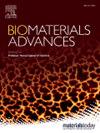Enhancing compliance and extracellular matrix properties of tissue-engineered vascular grafts through pulsatile bioreactor culture
IF 5.5
2区 医学
Q2 MATERIALS SCIENCE, BIOMATERIALS
Materials Science & Engineering C-Materials for Biological Applications
Pub Date : 2025-05-12
DOI:10.1016/j.bioadv.2025.214346
引用次数: 0
Abstract
Biofabrication techniques represent a promising avenue for the production of small diameter vascular grafts. However, while current tissue-engineered vascular grafts (TEVGs) fulfil certain functional requirements of native blood vessels, most exhibit very poor mechanical compliance, directly reducing patency in vivo. Here, highly compliant TEVGs were cultured in a dynamic pulsatile bioreactor which ensured enhanced compliance, using biomimetic melt electrowritten (MEW) tubular scaffolds as substrates for tissue growth. Through 6-week in vitro culture, we investigated differences in extracellular matrix (ECM) production and mechanical performance of TEVGs cultured with placental mesenchymal stem cells (MSCs) and smooth muscle cells (SMCs) in static and dynamic conditions. Pulsatile stimulation successfully maintained the high compliance (12.4 ± 0.8 % per 100 mmHg) of our biomimetic scaffolds, substantially greater than existing small diameter grafts. Dynamic TEVGs demonstrated physiologically relevant burst pressure (1125 ± 212 mmHg) and suture pull-out force (3.0 ± 0.4 N), while also accumulating greater ECM components than static TEVGs. To assess off-the-shelf suitability, grafts were decellularized and lyophilised to produce d-TEVGs, which exhibited negligible loss of mechanics or ECM integrity. Finally, rehydrated d-TEVGs were seeded with endothelial cells in vitro, with an intimal endothelial lining forming after 7 days. These findings demonstrate the production of TEVGs with specifically engineered mechanical compliance which has been maintained by dynamic in vitro culture, supporting continued work toward biofabrication of the next generation of vascular grafts.
通过脉冲生物反应器培养增强组织工程血管移植物的顺应性和细胞外基质特性
生物制造技术代表了生产小直径血管移植物的一个有前途的途径。然而,虽然目前的组织工程血管移植物(TEVGs)满足了天然血管的某些功能要求,但大多数表现出非常差的机械顺应性,直接降低了体内的通畅性。在这里,使用仿生熔体电写(MEW)管状支架作为组织生长的基质,在动态脉冲生物反应器中培养高度顺应性的tevg,以确保增强顺应性。通过体外培养6周,我们研究了静止和动态条件下胎盘间充质干细胞(MSCs)和平滑肌细胞(SMCs)培养的TEVGs细胞外基质(ECM)生成和力学性能的差异。脉冲刺激成功地维持了仿生支架的高顺应性(每100 mmHg 12.4±0.8%),大大高于现有的小直径移植物。动态tevg表现出与生理相关的破裂压力(1125±212 mmHg)和缝线拔出力(3.0±0.4 N),同时也比静态tevg积累了更多的ECM成分。为了评估现成的适用性,移植物被脱细胞和冻干以产生d- tevg,其力学或ECM完整性的损失可以忽略不计。最后,将复水化的d- tevg体外植入内皮细胞,7天后形成内膜内皮细胞。这些发现表明,TEVGs的生产具有特殊的工程机械顺应性,通过动态体外培养保持,支持下一代血管移植物生物制造的继续工作。
本文章由计算机程序翻译,如有差异,请以英文原文为准。
求助全文
约1分钟内获得全文
求助全文
来源期刊
CiteScore
17.80
自引率
0.00%
发文量
501
审稿时长
27 days
期刊介绍:
Biomaterials Advances, previously known as Materials Science and Engineering: C-Materials for Biological Applications (P-ISSN: 0928-4931, E-ISSN: 1873-0191). Includes topics at the interface of the biomedical sciences and materials engineering. These topics include:
• Bioinspired and biomimetic materials for medical applications
• Materials of biological origin for medical applications
• Materials for "active" medical applications
• Self-assembling and self-healing materials for medical applications
• "Smart" (i.e., stimulus-response) materials for medical applications
• Ceramic, metallic, polymeric, and composite materials for medical applications
• Materials for in vivo sensing
• Materials for in vivo imaging
• Materials for delivery of pharmacologic agents and vaccines
• Novel approaches for characterizing and modeling materials for medical applications
Manuscripts on biological topics without a materials science component, or manuscripts on materials science without biological applications, will not be considered for publication in Materials Science and Engineering C. New submissions are first assessed for language, scope and originality (plagiarism check) and can be desk rejected before review if they need English language improvements, are out of scope or present excessive duplication with published sources.
Biomaterials Advances sits within Elsevier''s biomaterials science portfolio alongside Biomaterials, Materials Today Bio and Biomaterials and Biosystems. As part of the broader Materials Today family, Biomaterials Advances offers authors rigorous peer review, rapid decisions, and high visibility. We look forward to receiving your submissions!

 求助内容:
求助内容: 应助结果提醒方式:
应助结果提醒方式:


